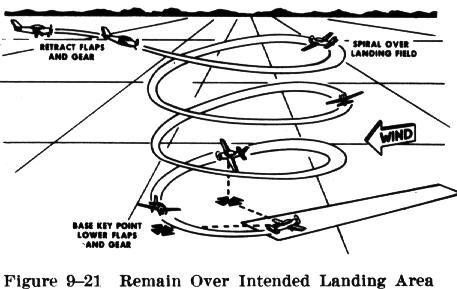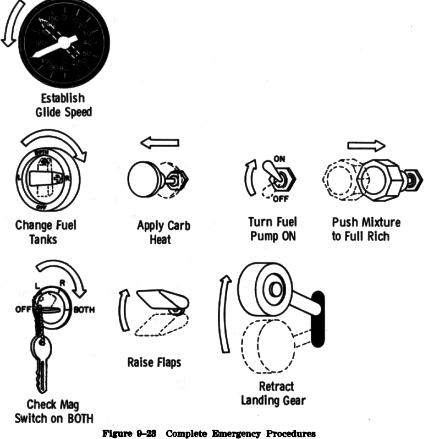Emergency Approaches (Simulated)
Emergency Approaches (Simulated)
From time to time on dual flights, the instructor should
give simulated forced landings by retarding the throttle and calling "Simulated
Forced Landing." The objective of these simulated forced landings is to
develop the pilot's accuracy, judgment, planning, technique, and confidence
when little or no power is available.
A simulated forced landing may be given with the airplane
in any configuration. When the instructor calls "simulated forced landing"
the pilot should immediately establish a glide attitude and ensure that
the landing gear and flaps are retracted (if so equipped). If the airspeed
is above the proper glide speed, altitude should be maintained (while retracting
the landing gear and flaps), and the airspeed allowed to dissipate to best
glide speed. When the proper glide speed is attained, the nose should then
be lowered to maintain that speed and the cockpit procedures performed
during the glide.
 |
A constant gliding speed should be maintained, because variations of
gliding speed nullify all attempts at accuracy in judgment of gliding distance
and the landing spot. The many variables such as altitude, obstruction,
wind direction, landing direction, landing surface and gradient, and landing
distance requirements of the airplane will determine the pattern and approach
techniques to use.
Utilizing any combination of normal gliding maneuvers,
from wings level to spirals, the pilot should eventually arrive at the
normal "key" position at a normal traffic pattern altitude for the selected
landing area. From this point on, the approach will be as nearly as possible
a normal power off approach (Fig. 9-21). |
With the greater choice of fields afforded by higher altitudes,
the inexperienced pilot may be inclined to delay making a decision, and
with considerable altitude in which to maneuver, errors in maneuvering
and estimation of glide distance may develop.
All pilots should learn to determine the wind direction
and estimate its speed from the windsock at the airport, smoke from factories
or houses, dust, brush fires, windmills, etc., and should constantly check
against these while in flight.
Once a field has been selected, the student pilot should
always be required to indicate it to the instructor. Normally, the student
should be required to plan and fly a pattern for landing on the field first
elected until the simulated forced landing is terminated by the instructor.
This will give the instructor an opportunity to explain and correct any
errors; it will also give the student an opportunity to see the results
of the errors. However, if the student realizes during the approach that
a poor field has been selected - one that would obviously result in disaster
if a landing were to be made - and there is a more advantageous field within
gliding distance, a change to the better field should be permitted. The
hazards involved in these last minute decisions, such as excessive maneuvering
at very low altitudes, should be thoroughly explained by the instructor.
Slipping the airplane, using flaps, varying the position
of the base leg, and varying the turn onto final approach should be stressed
as ways of correcting for misjudgment of altitude and glide angle.
Eagerness to get down is one of the most common faults
of inexperienced pilots during simulated forced landings. In giving way
to this, they forget about speed and arrive at the edge of the field with
too much speed to permit a safe landing. Too much speed may be just as
dangerous as too little; it results in excessive floating and overshooting
the desired landing spot. It should be impressed on the students that they
cannot dive at a field and expect to land on it, particularly with today's
sleek, modern airplanes.
During all simulated forced landings, the instructor should
control the throttle, ensure that the engine is kept warm and cleared,
and advance the throttle when the simulated forced landing approach is
ended. When the throttle is reopened by the instructor after the termination
of the approach, no doubt should exist in the student's mind as to who
has control of the airplane. Either the instructor or the student should
have complete control, since many near accidents have occurred from such
misunderstandings.
Every simulated forced landing approach should be terminated
as soon as it can be determined whether a safe landing could have been
made. However, in no case should it be continued to a point where it creates
an undue hazard or an annoyance to persons or property on the ground. NOTE:
Regulations state that aircraft may not be operated closer than 500 feet
to any person, vessel, vehicle, or structure.
| In addition to flying the airplane from the point of simulated
engine failure to where a reasonable safe landing could be made, the student
should also be taught certain emergency cockpit procedures. The habit of
performing these cockpit procedures should be developed to such an extent
that, when an engine failure actually occurs, the students will check the
critical items that would be necessary to get the engine operating again
while selecting a field and planning an approach. Combining the two operations
- accomplishing emergency procedures and planning and flying the approach
- will be difficult for the student during the early training in forced
landings.
There are definite steps and procedures to be followed in a simulated
forced landing. Although these may differ somewhat from the procedures
used in an actual emergency, they should be learned thoroughly by the student,
and each step called out to the instructor. The use of a checklist is strongly
recommended. Most airplane manufacturers provide a checklist of the appropriate
items (Fig. 9-22). |
--------------------------------------
: EMERGENCY
PROCEDURES :
:
:
: Engine Failure
:
: Airspeed
- Glide :
: Fuel selector - fullest tank
:
: Fuel pump
- ON
:
: Mixture
- RICH :
: Carb heat
- ON
:
: Magneto switch - BOTH
:
: Flaps
- UP
:
: Gear
- UP
:
: Seat belts
- fastened :
:
:
: EMERGENCY LANDING
:
--------------------------------------
Fig. 9-22 Check the Critical Items
|
 |
Critical items to be checked should include the position of the fuel
tank selector, the quantity of fuel in the tank selected, the fuel pressure
gauge to see if the electric fuel pump is needed, the position of the mixture
control, the position of the magneto switch, and the use of carburetor
heat Fig. 9-23).
Many actual forced landings have been made and later found to be the
result of the fuel selector valve being positioned to an empty tank while
the other tank had plenty of fuel. It may be wise to change the position
of the fuel selector valve even though the fuel gauge indicates fuel in
all tanks, as fuel gauges have been known to be inaccurate. No doubt many
actual forced landings could have been prevented if the pilots had developed
the habit of checking these critical items during their flight training
to the extent that it carried over into their later flying.
Instruction in emergency procedures should by no means be limited to
simulated forced landings caused by power failures. Other emergencies associated
with the operation of the airplane should be explained, demonstrated, and
practiced if practicable. Among these emergencies are such occurrences
as fire in flight, electrical or hydraulic systems malfunctions, |
unexpected severe weather conditions, engine overheating, imminent fuel
exhaustion, and the emergency operation of airplane systems and equipment.

